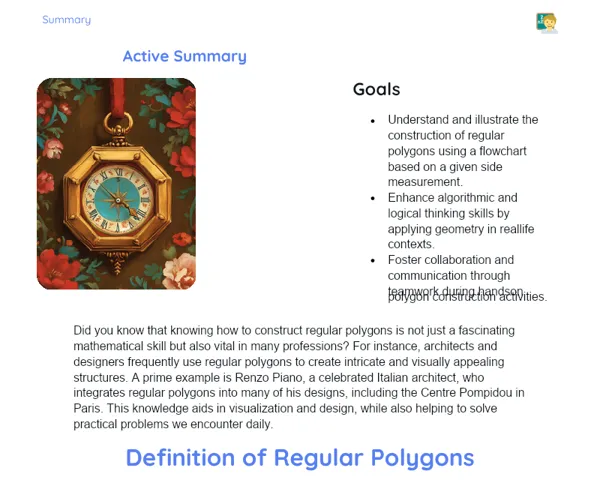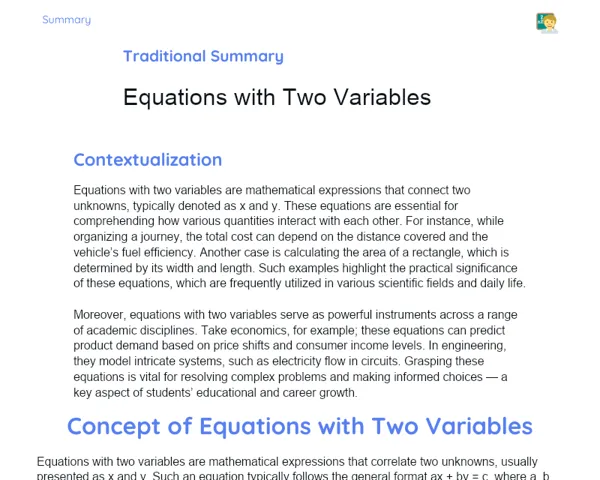Objectives
1. 🎯 Master the mathematical notation of factorials and apply it to solve challenging expressions and calculations.
2. 🎯 Understand and utilize the fundamental properties of factorials, including recursive definitions and basic operations.
3. 🎯 Develop logical reasoning skills and practical applications, preparing to tackle more complex mathematical problems.
Contextualization
Did you know that the concept of factorial isn't merely a mathematical tool, but plays a crucial role in many fields of study and technology? For example, in computer science, factorials help in analyzing the efficiency of algorithms, especially in brute force scenarios where we need to consider all possible solutions. Moreover, factorials are vital in statistics for calculating combinations and permutations, which are essential in experiments and data analysis. Therefore, mastering factorials is more than just about pure mathematics; it's about gaining a powerful tool for various practical applications.
Important Topics
Definition and Notation of Factorial
The factorial of a number, denoted by n!, is the product of all positive integers less than or equal to that number. For instance, 5! = 5 x 4 x 3 x 2 x 1 = 120. The use of the exclamation mark is an effective way to indicate repetitive products, commonly seen in mathematics and other sciences.
-
The factorial of 0 is 1, which is a special case fundamental in many combinatorial calculations.
-
The recursive definition of factorial, n! = n x (n-1)!, is useful for simplifying expressions and understanding large factorial formations.
-
The principle that n! = n x (n-1)! aids in simplifying algebraic expressions and speeds up calculations.
Properties of Factorial
Beyond the recursive definition, factorials have other key properties like n! = n x (n-1)! and n! = n x (n-1) x (n-2)! which are essential for advanced calculations. These properties clarify the relationships among different factorials and are frequently used to ease calculations and mathematical expressions.
-
The property n! = n x (n-1)! is crucial for calculating large factorials swiftly and efficiently.
-
The factorial of an even number always ends with a 0, while that of an odd number ends with a 5.
-
Factorials are applied to compute combinations and permutations, which are fundamental in statistics and probability.
Practical Applications of Factorials
Factorials are not merely theoretical; they have real-life applications across various domains. In computer science, for instance, they are utilized in algorithm analysis and in coding arrangements and permutations. In statistics, factorials are fundamental for computing combinations and permutations, which are critical in experiments and data modeling.
-
In computer science, factorials support the understanding and optimization of algorithm complexity.
-
In statistics, factorials are crucial for calculating possible arrangements or combinations, essential for data analysis.
-
Factorials often appear in games and puzzles, where calculating possibilities is vital for developing strategies and solutions.
Key Terms
-
Factorial (n!): The product of all positive integers less than or equal to n.
-
Factorial Notation: The mathematical representation of factorials using the exclamation point, like n!.
-
Recursive Definition: A method of defining a function in terms of itself, such as n! = n x (n-1)!
For Reflection
-
How can factorial notation simplify complex calculations and mathematical expressions?
-
In what ways can the property n! = n x (n-1)! be used to solve everyday problems or in other disciplines?
-
Why is it essential to grasp the concept of factorial for fields like computer science and statistics?
Important Conclusions
-
We explored the concept of factorial, its notation, and fundamental properties, including the recursive definition, which are crucial for simplifying calculations and understanding more complex mathematical patterns.
-
We discussed how factorials extend beyond theory, having practical applications in fields like computer science, statistics, and even in games and puzzles, which highlights their relevance in daily life and other disciplines.
-
We emphasized the importance of mastering factorials to develop logical reasoning skills, problem-solving abilities, and a deeper comprehension of more advanced mathematical concepts.
To Exercise Knowledge
- Calculate the factorials of numbers ranging from 1 to 10 and spot interesting patterns. 2. Create factorial problems for your friends or family and challenge them to solve. 3. Apply factorials in tackling probability and statistics problems found in textbooks or online resources.
Challenge
Super Factorial Challenge: Compute the factorial of the factorial of the first 5 prime numbers (2, 3, 5, 7, 11) and see if you can express the result in a simplified form. This challenge will put your understanding of factorials and mathematical properties to the test!
Study Tips
-
Practice the notation and calculation of factorials frequently to keep your understanding sharp and boost your quick calculation skills.
-
Utilize online resources, like factorial calculators, to verify your answers and explore larger factorials that might be tough to calculate manually.
-
Discuss with your peers or teachers about real-world applications of factorials in mathematics, computer science, and statistics to appreciate the versatility and significance of these concepts.



